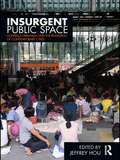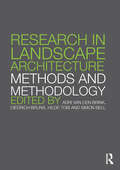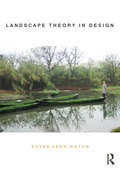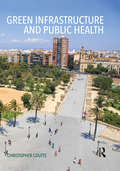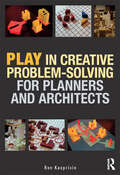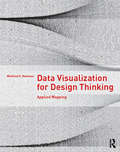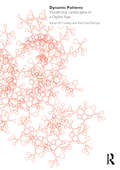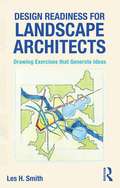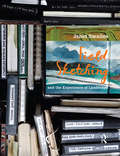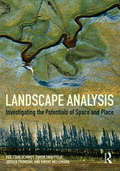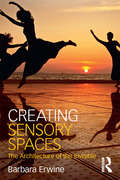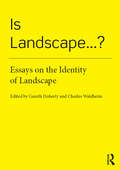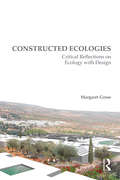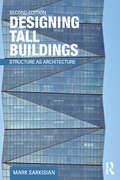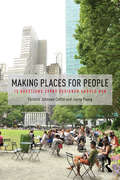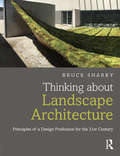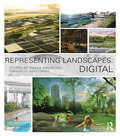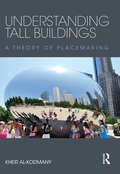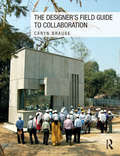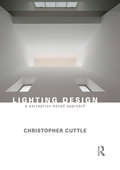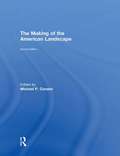- Table View
- List View
Insurgent Public Space: Guerrilla Urbanism and the Remaking of Contemporary Cities
by Jeffrey HouWinner of the EDRA book prize for 2012. In cities around the world, individuals and groups are reclaiming and creating urban sites, temporary spaces and informal gathering places. These ‘insurgent public spaces’ challenge conventional views of how urban areas are defined and used, and how they can transform the city environment. No longer confined to traditional public areas like neighbourhood parks and public plazas, these guerrilla spaces express the alternative social and spatial relationships in our changing cities. With nearly twenty illustrated case studies, this volume shows how instances of insurgent public space occur across the world. Examples range from community gardening in Seattle and Los Angeles, street dancing in Beijing, to the transformation of parking spaces into temporary parks in San Francisco. Drawing on the experiences and knowledge of individuals extensively engaged in the actual implementation of these spaces, Insurgent Public Space is a unique cross-disciplinary approach to the study of public space use, and how it is utilized in the contemporary, urban world. Appealing to professionals and students in both urban studies and more social courses, Hou has brought together valuable commentaries on an area of urbanism which has, up until now, been largely ignored.
Insurgent Public Space: Guerrilla Urbanism and the Remaking of Contemporary Cities
by Jeffrey HouWinner of the EDRA book prize for 2012. In cities around the world, individuals and groups are reclaiming and creating urban sites, temporary spaces and informal gathering places. These ‘insurgent public spaces’ challenge conventional views of how urban areas are defined and used, and how they can transform the city environment. No longer confined to traditional public areas like neighbourhood parks and public plazas, these guerrilla spaces express the alternative social and spatial relationships in our changing cities. With nearly twenty illustrated case studies, this volume shows how instances of insurgent public space occur across the world. Examples range from community gardening in Seattle and Los Angeles, street dancing in Beijing, to the transformation of parking spaces into temporary parks in San Francisco. Drawing on the experiences and knowledge of individuals extensively engaged in the actual implementation of these spaces, Insurgent Public Space is a unique cross-disciplinary approach to the study of public space use, and how it is utilized in the contemporary, urban world. Appealing to professionals and students in both urban studies and more social courses, Hou has brought together valuable commentaries on an area of urbanism which has, up until now, been largely ignored.
Research in Landscape Architecture: Methods and Methodology
by Adri van den Brink Diedrich Bruns Hilde Tobi Simon BellDefining a research question, describing why it needs to be answered and explaining how methods are selected and applied are challenging tasks for anyone embarking on academic research within the field of landscape architecture. Whether you are an early career researcher or a senior academic, it is essential to draw meaningful conclusions and robust answers to research questions.Research in Landscape Architecture provides guidance on the rationales needed for selecting methods and offers direction to help to frame and design academic research within the discipline. Over the last couple of decades the traditional orientation in landscape architecture as a field of professional practice has gradually been complemented by a growing focus on research. This book will help you to develop the connections between research, teaching and practice, to help you to build a common framework of theory and research methods.Bringing together contributions from landscape architects across the world, this book covers a broad range of research methodologies and examples to help you conduct research successfully. Also included is a study in which the editors discuss the most important priorities for the research within the discipline over the coming years. This book will provide a definitive path to developing research within landscape architecture.
Landscape Theory in Design
by Susan HerringtonPhenomenology, Materiality, Cybernetics, Palimpsest, Cyborgs, Landscape Urbanism, Typology, Semiotics, Deconstruction - the minefield of theoretical ideas that students must navigate today can be utterly confusing, and how do these theories translate to the design studio? Landscape Theory in Design introduces theoretical ideas to students without the use of jargon or an assumption of extensive knowledge in other fields, and in doing so, links these ideas to the processes of design. In five thematic chapters Susan Herrington explains: the theoretic groundings of the theory of philosophy, why it matters to design, an example of the theory in a work of landscape architecture from the twentieth and twenty-first centuries, debates surrounding the theory (particularly as they elaborate modern and postmodern thought) and primary readings that can be read as companions to her text. An extensive glossary of theoretical terms also adds a vital contribution to students’ comprehension of theories relevant to the design of landscapes and gardens. Covering the design of over 40 landscape architects, architects, and designers in 111 distinct projects from 20 different countries, Landscape Theory in Design is essential reading for any student of the landscape.
Green Infrastructure and Public Health
by Christopher CouttsThere is a growing body of knowledge revealing a sweeping array of connections between public health and green infrastructure – but not until now have the links between them been brought together in one comprehensive book. Green Infrastructure and Public Health provides an overview of current research and theories of the ecological relationships and mechanisms by which the environment influences human health and health behaviour. Covering a broad spectrum of contemporary understanding, Coutts outlines: public health models that explicitly promote the importance of the environment to health ways in which the quality of the landscape is tied to health challenges of maintaining viable landscapes amidst a rapidly changing global environment This book presents the case for fundamental human dependence on the natural environment and creates a bridge between contemporary science on the structure and form of a healthy landscape and the myriad ways that a healthy landscape supports healthy human beings. It presents ideal reading for students and practitioners of landscape architecture, urban design, planning, and health studies.
Play in Creative Problem-solving for Planners and Architects
by Ron KasprisinIn Play in Creative Problem-solving for Planners and Architects, "play" is defined, explored and demonstrated as a critical catalyst in creative problem-solving processes. The book defines the current psychological research into play and creative problem-solving, explores the necessary integration of the two, and exemplifies for students and practitioners the use of play in creative endeavors; and the role that play serves in separating linear from creative problem-solving approaches. Play is explored regarding its elements (tools, skills, environment), characteristics (a free activity without failure) and attitude as it relates to and activates the creative process with the focus on urban design, planning, architecture, and landscape architecture. The book re-establishes the whole mind-body thinking process of play as a means of object-learning; to provide designers and planners with alternative ways of design-thinking; and to challenge the over-utilization of digital technologies in creative processes. Creative problem-solving requires an appreciation for ambiguity, uncertainty of outcome, complexity that leads to the discovery of novelty and innovation. The book incorporates examples and exercises in play activities related to the design and planning fields, and exercises related to play-tools and skills for students and professionals. It also defines terms used in play and creativity psychology; provides examples and structure for play and creative problem-solving activities; describes the type and use of appropriate play-tools; contains an extensive bibliography on play and creative problem-solving texts; and provides significant illustrations making it fundamental reading for students and professionals in urban design and planning fields.
Data Visualization for Design Thinking: Applied Mapping
by Winifred E. NewmanData Visualization for Design Thinking helps you make better maps. Treating maps as applied research, you’ll be able to understand how to map sites, places, ideas, and projects, revealing the complex relationships between what you represent, your thinking, the technology you use, the culture you belong to, and your aesthetic practices. More than 100 examples illustrated with over 200 color images show you how to visualize data through mapping. Includes five in-depth cases studies and numerous examples throughout.
Dynamic Patterns: Visualizing Landscapes in a Digital Age
by Karen M'Closkey Keith VanDerSysDynamic Patterns explores the role of patterns in designed landscapes. Patterns are inherently relational, and the search for and the creation of patterns are endemic to many scientific and artistic endeavors. Recent advances in optical tools, sensors, and computing have expanded our understanding of patterns as a link between natural and cultural realms. Looking beyond the surface manifestation of pattern, M’Closkey and VanDerSys delve into a multifaceted examination that explores new avenues for engagement with patterns using digital media. Examining the theoretical implications of pattern-making, they probe the potential of patterns to conjoin landscape’s utilitarian and aesthetic functions. With full color throughout and over one hundred and twenty images, Dynamic Patterns utilizes work from a wide range of artists and designers to demonstrate how novel modes of visualization have facilitated new ways of seeing patterns and therefore of understanding and designing landscapes.
Design Readiness for Landscape Architects: Drawing Exercises that Generate Ideas
by Les H. SmithDemands on landscape architecture students’ time are many and varied – when is there a chance to just sketch, and is it worth dedicating your time to the pursuit of drawing? This book shows how in short bursts you can build up your design skills using quick, relaxed sketches, which form the basis for full projects and studio work. This book will provide you with your own image library – sources of inspiration, guidance, and short-cuts to future designs. A variety of paths leading to design discovery, based upon experimental sketching methods, are discussed, demonstrated, and then put into action with valuable exercises. These exercises focus your sketching, giving hints and tips on what to look for, how to capture the essence of the object or location, and how to become a natural in the art of speedy visual communication. Real-life examples of the author’s built-works as a landscape architect show how professionals use these techniques in their own design creations. Design Readiness for Landscape Architects presents enjoyable and thought-stirring essays and drawing-based exercises to help students grow more facile and agile in their service as architects of the land, whether using tablets, paints, or pens and pencils.
Field Sketching and the Experience of Landscape
by Janet SwailesThe act of field sketching allows us to experience the landscape first-hand – rather than reliance upon plans, maps and photographs at a distance, back in the studio. Aimed primarily at landscape architects, Janet Swailes takes the reader on a journey through the art of field sketching, providing guidance and tips to develop skills from those starting out on a design course, to those looking to improve their sketching. ?Combining techniques from landscape architecture and the craft and sensibilities of arts practice, she invites us to experience sensations directly out in the field to enrich our work: to look closely at the effects of light and weather; understand the lie and shapes of the land through travel and walking; and to consider lines of sight from the inside out as well as outside in. Full colour throughout with examples, checklists and case studies of other sketchers’ methods, this is an inspirational book to encourage landscape architects to spend more time in the field and reconnect with the basics of design through drawing practice.
Landscape Analysis: Investigating the potentials of space and place
by Per Stahlschmidt Simon Swaffield Jorgen Primdahl Vibeke NellemannA key aspect of town planning, landscape planning and landscape architecture is to identify and then use the distinctive features and characteristics of space, place and landscape to achieve environmental quality. Landscape Analysis provides an introduction to the field both in theory and in practice. A wide range of methods and techniques for landscape analysis is illustrated by urban and rural examples from many countries. Analysing landscapes within a planning context requires both skill and insights. Drawing upon numerous concrete examples, together with an examination of some theoretical concepts, this book guides the reader through a wide range of different approaches and techniques of landscape analysis that may be applied at different scales, from elementary site analysis to historical and regional studies. This is an essential book for students and graduate practitioners working in landscape architecture, planning and architecture.
Creating Sensory Spaces: The Architecture of the Invisible
by Barbara ErwineCreating Sensory Spaces celebrates spaces enlivened with sensual richness and provides you with the knowledge and tools necessary to create them. Drawing on numerous built case studies in ten countries and illustrated with over 85 full color images, the book presents a new framework for the design of sensory spaces including light, color, temperature, smell, sound, and touch. Bridging across disciplines of architecture, engineering, phenomenology and perceptual psychology, this book informs the design of buildings and neighborhoods that reclaim the role of the body and all the senses in creating memorable experiences of place and belonging.
Is Landscape... ?: Essays on the Identity of Landscape
by Gareth Doherty Charles WaldheimIs Landscape . . . ? surveys multiple and myriad definitions of landscape. Rather than seeking a singular or essential understanding of the term, the collection postulates that landscape might be better read in relation to its cognate terms across expanded disciplinary and professional fields. The publication pursues the potential of multiple provisional working definitions of landscape to both disturb and develop received understandings of landscape architecture. These definitions distinguish between landscape as representational medium, academic discipline, and professional identity. Beginning with an inquiry into the origins of the term itself, Is Landscape . . . .? features essays by a dozen leading voices shaping the contemporary reading of landscape as architecture and beyond.
Constructed Ecologies: Critical Reflections on Ecology with Design
by Margaret GroseToday, designers are shifting the practice of landscape architecture towards the need for a more complex understanding of ecological science. Constructed Ecologies presents ecology as critical theory for design, and provides major ideas for design that are supported with solid and imaginative science. In the questioning narrative of Constructed Ecologies, the author discards many old and tired theories in landscape architecture. With detailed documentation, she casts off the savannah theory, critiques the search for universals, reveals the needed role of designers in large-scale agriculture, abandons the overlay technique of McHarg, and introduces the ecological and urban health urgency of public night lighting. Margaret Grose presents wide-ranging new approaches and shows the importance of learning from science for design, of going beyond assumptions, of working in multiple rather than single issues, of disrupting linear design thinking, and of dealing with data. This book is written with a clear voice by an ecologist and landscape architect who has led design students into loving ecological science for the support it gives design.
Designing Tall Buildings: Structure as Architecture
by Mark SarkisianThis second edition of Designing Tall Buildings, an accessible reference to guide you through the fundamental principles of designing high-rises, features two new chapters, additional sections, 400 images, project examples, and updated US and international codes. Each chapter focuses on a theme central to tall-building design, giving a comprehensive overview of the related architecture and structural engineering concepts. Author Mark Sarkisian, PE, SE, LEED® AP BD+C, provides clear definitions of technical terms and introduces important equations, gradually developing your knowledge. Projects drawn from SOM’s vast portfolio of built high-rises, many of which Sarkisian engineered, demonstrate these concepts. This book advises you to consider the influence of a particular site's geology, wind conditions, and seismicity. Using this contextual knowledge and analysis, you can determine what types of structural solutions are best suited for a tower on that site. You can then conceptualize and devise efficient structural systems that are not only safe, but also constructible and economical. Sarkisian also addresses the influence of nature in design, urging you to integrate structure and architecture for buildings of superior performance, sustainability, and aesthetic excellence.
Designing Tall Buildings: Structure as Architecture
by Mark SarkisianThis second edition of Designing Tall Buildings, an accessible reference to guide you through the fundamental principles of designing high-rises, features two new chapters, additional sections, 400 images, project examples, and updated US and international codes. Each chapter focuses on a theme central to tall-building design, giving a comprehensive overview of the related architecture and structural engineering concepts. Author Mark Sarkisian, PE, SE, LEED® AP BD+C, provides clear definitions of technical terms and introduces important equations, gradually developing your knowledge. Projects drawn from SOM’s vast portfolio of built high-rises, many of which Sarkisian engineered, demonstrate these concepts. This book advises you to consider the influence of a particular site's geology, wind conditions, and seismicity. Using this contextual knowledge and analysis, you can determine what types of structural solutions are best suited for a tower on that site. You can then conceptualize and devise efficient structural systems that are not only safe, but also constructible and economical. Sarkisian also addresses the influence of nature in design, urging you to integrate structure and architecture for buildings of superior performance, sustainability, and aesthetic excellence.
Making Places for People: 12 Questions Every Designer Should Ask
by Christie Johnson Coffin Jenny Young** Honorable Mention at the 2019 ERDA Great Places Awards ** Making Places for People explores twelve social questions in environmental design. Authors Christie Johnson Coffin and Jenny Young bring perspectives from practice and teaching to challenge assumptions about how places meet human needs. The book reveals deeper complexities in addressing basic questions, such as: What is the story of this place? What logic orders it? How big is it? How sustainable is it? Providing an overview of a growing body of knowledge about people and places, Making Places for People stimulates curiosity and further discussion. The authors argue that critical understanding of the relationships between people and their built environments can inspire designs that better contribute to health, human performance, and social equity—bringing meaning and delight to people’s lives.
Thinking about Landscape Architecture: Principles of a Design Profession for the 21st Century
by Bruce SharkyWhat is landscape architecture? Is it gardening, or science, or art? In this book, Bruce Sharky provides a complete overview of the discipline to provide those that are new to the subject with the foundations for future study and practice. The many varieties of landscape practice are discussed with an emphasis on the significant contributions that landscape architects have made across the world in daily practice.? Written by a leading scholar and practitioner, this book outlines the subject and explores how, from a basis in garden design, it 'leapt over the garden wall' to encapsulate areas such as urban and park design, community and regional planning, habitat restoration, green infrastructure and sustainable design, and site engineering and implementation. Coverage includes: The effects that natural and human factors have upon design, and how the discipline is uniquely placed to address these challenges? Examples of contemporary landscape architecture work - from storm water management and walkable cities to well-known projects like the New York High Line and the London Olympic Park? Exploration of how art and design, science, horticulture, and construction come together in one subject? Thinking about Landscape Architecture is perfect for those wanting to better understand this fascinating subject, and those starting out as landscape architecture students.
Representing Landscapes: Digital
by Nadia AmorosoMost landscape architectural designs now include some form of digital representation - but there is much more scope for creativity beyond the standard Photoshop montages. In this new book on representing landscapes, Nadia Amoroso brings together contributions from some of the leading landscape departments in the world to explore the variety in digital illustration methods. In each chapter, leading lecturers, professors and practitioners in the field of landscape architecture explain a specific digital approach with the use of images from their department to show how each technique can be used in inspirational examples. Throughout the book over 200 colour images cover the spectrum of digital representation to help discuss the various drawing types which are invaluable when communicating ideas in the field of landscape architecture. With worked examples in the chapters and downloadable images suitable for class use, this is an essential book for visual communication and design studios.
Representing Landscapes: Digital
by Nadia AmorosoMost landscape architectural designs now include some form of digital representation - but there is much more scope for creativity beyond the standard Photoshop montages. In this new book on representing landscapes, Nadia Amoroso brings together contributions from some of the leading landscape departments in the world to explore the variety in digital illustration methods. In each chapter, leading lecturers, professors and practitioners in the field of landscape architecture explain a specific digital approach with the use of images from their department to show how each technique can be used in inspirational examples. Throughout the book over 200 colour images cover the spectrum of digital representation to help discuss the various drawing types which are invaluable when communicating ideas in the field of landscape architecture. With worked examples in the chapters and downloadable images suitable for class use, this is an essential book for visual communication and design studios.
Understanding Tall Buildings: A Theory of Placemaking
by Kheir Al-KodmanyIn recent years, the rapid pace of tall building construction has fostered a certain kind of placelessness, with many new tall buildings being built out of scale, context and place. By analyzing hundreds of tall buildings and by providing hundreds of visuals that inspire, stimulate and engage, Understanding Tall Buildings contends that well-designed tall buildings can rejuvenate cities, ignite economic activity, support social life and boost city pride. Although this book does not claim to possess all the solutions, it does propose specific tall building design guidelines that may help to promote placemaking. Through this work, it is the author’s hope that ill-conceived developments will become less common in the future and that good placemaking will become the norm, not the exception. This book is a must-read for students and practitioners working to create better tall buildings and better urban environments.
The Designer's Field Guide to Collaboration
by Caryn BrauseThe Designer’s Field Guide to Collaboration provides practitioners and students with the tools necessary to collaborate effectively with a wide variety of partners in an increasingly socially complex and technology-driven design environment. Beautifully illustrated with color images, the book draws on the expertise of top professionals in the allied fields of architecture, landscape architecture, engineering and construction management, and brings to bear research from diverse disciplines such as software development, organizational behavior, and outdoor leadership training. Chapters examine emerging and best practices for effective team building, structuring workflows, enhancing communication, managing conflict, and developing collective vision––all to ensure the highest standards of design excellence. Case studies detail and reflect on the collaborative processes used to create award-winning projects by Studio Gang, Perkins+Will, Tod Williams Billie Tsien Architects | Partners, Gensler, CDR Studio, Mahlum Architects, In.Site:Architecture, and Thornton Tomasetti’s Core Studio. The book also provides pragmatic ideas and formal exercises for brainstorming productively, evaluating ideas, communicating effectively, and offering feedback. By emphasizing the productive influence and creative possibilities of collaboration within the changing landscape of architectural production, the book proposes how these practices can be taught in architecture school and expanded in practice. In a changing world that presents increasingly complex challenges, optimizing these collaborative skills will prove not only necessary, but crucial to the process of creating advanced architecture.
Lighting Design: A Perception-Based Approach
by Christopher CuttleBy reading this book, you will develop the skills to perceive a space and its contents in light, and be able to devise a layout of luminaires that will provide that lit appearance. Written by renowned lighting expert Christopher (Kit) Cuttle, the book: explains the difference between vision and perception, which is the distinction between providing lighting to make things visible, and providing it to influence the appearance of everything that is visible; demonstrates how lighting patterns generated by three-dimensional objects interacting with directional lighting are strongly influential upon how the visual perception process enables us to recognize object attributes, such as lightness, colourfulness, texture and gloss; reveals how a designer who understands the role of these lighting patterns in the perceptual process may employ them either to reveal, or to subdue, or to enhance the appearance of selected object attributes by creating appropriate spatial distributions of light; carefully explains calculational techniques and provides easy-to-use spreadsheets, so that layouts of lamps and luminaires are derived that can be relied upon to achieve the required illumination distributions. Practical lighting design involves devising three-dimensional light fields that create luminous hierarchies related to the visual significance of each element within a scene. By providing you with everything you need to develop a design concept - from the understanding of how lighting influences human perceptions of surroundings, through to engineering efficient and effective lighting solutions – Kit Cuttle instills in his readers a new-found confidence in lighting design.
The Making of the American Landscape
by Michael P. ConzenThe only compact yet comprehensive survey of environmental and cultural forces that have shaped the visual character and geographical diversity of the settled American landscape. The book examines the large-scale historical influences that have molded the varied human adaptation of the continent’s physical topography to its needs over more than 500 years. It presents a synoptic view of myriad historical processes working together or in conflict, and illustrates them through their survival in or disappearance from the everyday landscapes of today.
The Making of the American Landscape
by Michael P. ConzenThe only compact yet comprehensive survey of environmental and cultural forces that have shaped the visual character and geographical diversity of the settled American landscape. The book examines the large-scale historical influences that have molded the varied human adaptation of the continent’s physical topography to its needs over more than 500 years. It presents a synoptic view of myriad historical processes working together or in conflict, and illustrates them through their survival in or disappearance from the everyday landscapes of today.
